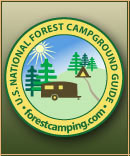Forest Information
The Grand Mesa National Forest is comprised of 346,219 acres and
is located western Colorado. There are 12 developed campgrounds
of which 11 met the selection criteria.
To reach the Grand Mesa National Forest, one must climb nearly 6000 feet to its lofty heights. Located on top of the world's largest flat-top mountain, the Forest is a wondrous place to behold. The Grand Mesa National Forest is full of crystal blue lakes, diverse wildlife, hiker-friendly trails, seclude dispersed camping locations, and spacious campgrounds in the cool shade of mature woods.
Geologically, Grand Mesa National Forest is actually a mountain capped with as many as 25 different lava flows. Today, the massive lava flows, some as deep as 600 feet, can be seen in the talus field along the Grand Mesa Scenic and Historic Byway, State Route 65. The lava has protected the softer soil below from the erosion of rain and ice for 10 million years. So, although the glaciers of the long ago Wisconsin Ice Age carved such nearby sights as the Powderhorn, the Grand Mesa continues to tower over the valleys below.
The scenic drive to Grand Mesa National Forest passes through transitions known as "Life Zones." Each Zone represents a different environment with plants, wildlife, and weather specific to that Zone. The Upper Sonoran Life Zone, at the beginning of the climb, features a dry climate, hot temperatures and plants of juniper, Pinyon pine and sagebrush. The Mountain Shrub Zone and Mountain Zone feature cool temperatures and Gambel oaks and aspen. The Sub-Alpine Zone, atop the Grand Mesa, is known for a wetter climate, colder temperatures, lush meadows of grass and wild flowers and stands of Aspen, Englemann spruce and Douglas fir.
The milder temperatures and more abundant water supply have attracted human beings to the Grand Mesa for thousands of years. By the 1880s farmers in the valley below relied on the Mesa's abundant water to irrigate their fields and ranchers were moving their cattle on to the Mesa for the lush summer grazing. Several rancher cabins have been preserved by the Forest Service and provide a glimpse of the life those rugged individuals lead.
While the cooler temperatures found in Grand Mesa National Forest have drawn people to its heights for many years, fishing is probably its oldest recreational attraction. Promoted since 1893 by the Mesa Resort Company, native, rainbow, and cutthroat trout can be found in most of the Mesa's nearly 500 stream-fed lakes. To provide access to fishing and other recreational opportunities a roadway was initially constructed up to the Mesa in 1895 and has been "improved" several times since then.
An alternative access route for the more adventurous is the "Veteran Road." Built by the Civilian Conservation Corps in the mid-1930s, this twisting and rocky route has some of the most spectacular vistas of Grand Junction, Colorado and beyond into Utah. Known today as Lands End Road, this route winds its way to a Visitors Center, built of native stone, in the middle of a wildflower-covered point of land. Here, volunteers welcome visitors to the Forest with pleasant conversation, lots of information, and, when necessary, a roaring fire. (The story goes, years before one enterprising volunteer also offered coffee, sandwiches, and soup.)
Either route to Grand Mesa National Forest's eye-popping beauty is a "long pull" for recreational vehicle (RV) and motorhome camping enthusiasts but many consider it worth the efforts. While car and tent camping sites may be more abundant, the Forest's many towering Englemann spruce and large fields of wildflowers attract all types of campers. Whether on a family camping vacations or a solitary camper looking for the prefect dispersed camp site, Grand Mesa's camping locations are outstanding.
With close to 200 miles of trails across Grand Mesa National Forest, hiking, horseback riding, mountain biking, and ATV trails are plentiful. Because the trails are located on a flat-top mountain, they are not the "lung-busting" type of hikes commonly found in Colorado, making the Forest a popular destination for hikers. But remember to take it easy for a few days to reduce the risk of elevation sickness.
Crag Crest National Recreation Trail is probably the most popular hiking trail in the Forest. This 10-mile trail, with an upper section along the landmark known as Crag Crest, is open to foot traffic only and its lower section, open to horses and mountain bikes, provides Forest visitors with a close-up look of the Grand Mesa National Forest. Other popular hiking trails are West Bench, Lost Lake, and Deep Creek trails, all near the Jumbo campground. For more information about trails and to obtain trail maps, contact the Grand Mesa National Forest.
Grand Mesa National Forest is a lush forest of numerous lakes, meadows of thick, tall grass and wildflowers, and dense stands of Aspen, Douglas fir, and Englemann spruce. All of the features that make the Forest attractive to humans seem to make it ideal for mosquitoes. To enjoy Grand Mesa National Forest to its fullest, be sure to bring mosquito repellent - industrial strength.
Rising almost straight up from the valley floor, Grand Mesa National Forest is a landmark and an oasis of cool temperatures, lush woods, teeming lakes, and abundant wildlife. Though considered a small forest by some, Grand Mesa National Forest is big on beauty, solitude and diverse recreation opportunities.
ADDRESSES
SUPERVISOR ADDRESS
2250 US Highway 50
Delta, Colorado 81416
970-874-6600
RANGER DISTRICT ADDRESS
Grand Valley
2777 Crossroads, Unit A
Grand Junction, Colorado 81506
970-242-8211 |
